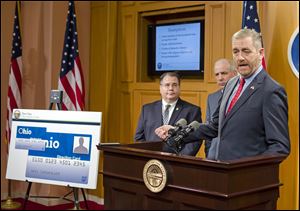
FEATURED EDITORIAL
Wrong problem; wrong solution
2/17/2017Last week, state Auditor David Yost, who recently announced he’s running for Ohio attorney general, and some state legislators pitched a plan to address food-stamp fraud by requiring that SNAP cards include a photo of the person to whom the card was rightfully issued. This, Mr. Yost said, will deter drug dealers who use the cards as an underground currency.
While a photo ID would be helpful to poor people who don’t drive, it won’t do much to deter either fraud or drug dealers.
Click here to view more Blade editorials

State Auditor David Yost and legislators last week pitched a plan to address food-stamp fraud, saying placing a name on the cards received from the state would deter drug dealers who use the cards as underground currency.
SNAP card trafficking, as the practice Mr. Yost described is known, accounts for a relatively small amount of fraud in the food-stamp system, according to audits from the United States Department of Agriculture. The USDA estimates trafficking amounts to about 1 penny for every dollar in the SNAP program.
The problem tends to be at the seller, not at the buyer, end.
After the USDA’s 2013 audit of food-stamp fraud, the agency launched measures aimed at tracking and punishing retailers who traffic in SNAP cards, creating fines for violating retailers and a process for permanently barring repeat offenders.
The agency’s investigation that year involved a review of more than 15,000 stores, deeper investigations of 5,000 of those, and permanent disqualification of 1,387 stores the agency discovered were trafficking in SNAP cards.
“Our message today is clear and firm: abuse of SNAP benefits — and the American taxpayer’s trust — will not be tolerated and carries severe consequences,” Under Secretary for Food, Nutrition and Consumer Services Kevin Concannon said at the time. “In the coming year, we will take further steps to strengthen SNAP integrity and continue to hold accountable those few bad actors that try to take advantage of the program.”
Mark Dunlea, a former president of the Hunger Action Network of New York, told Fox Business that year that retailers are more often the instigators of fraud than benefit recipients are. Small food retailers in poor neighborhoods with thin profit margins have a strong incentive to buy the cards for less than face value.
Mr. Yost, for his part, admits that, under his proposed system, retailers would not be required to refuse to sell food to customers who use a card with someone else’s photo on it. Instead, the sellers would be allowed to report those customers later. So how would a photo ID stop, or even discourage, SNAP card trafficking?
Mr. Yost has identified the wrong problem and the wrong solution to it. If he is serious about combating trafficking in SNAP cards, he should advocate increased penalties for retailers who agree to buy them. If he is serious about helping poor people get off food stamps, Mr. Yost should develop ideas for economic development in Ohio’s many impoverished small towns.